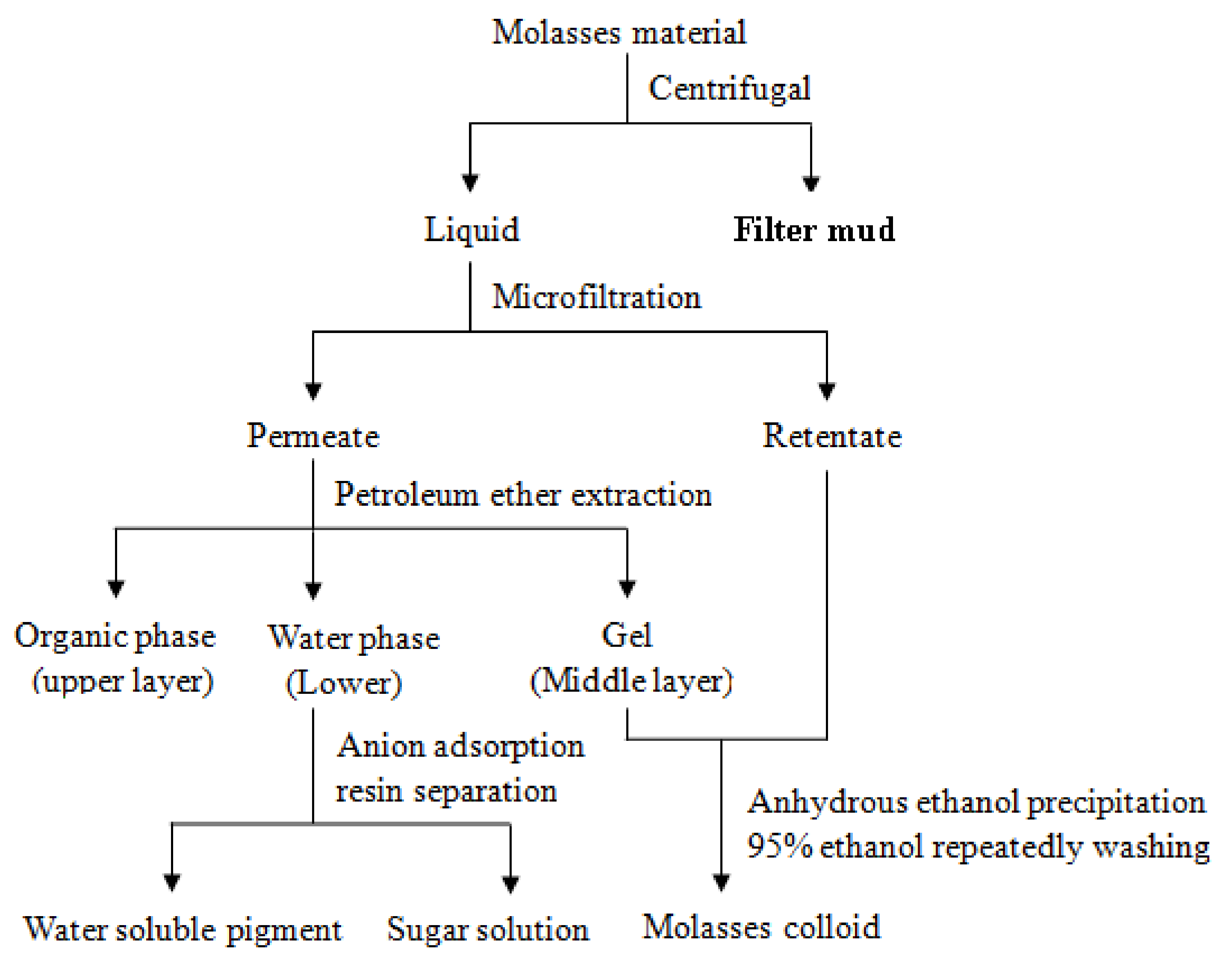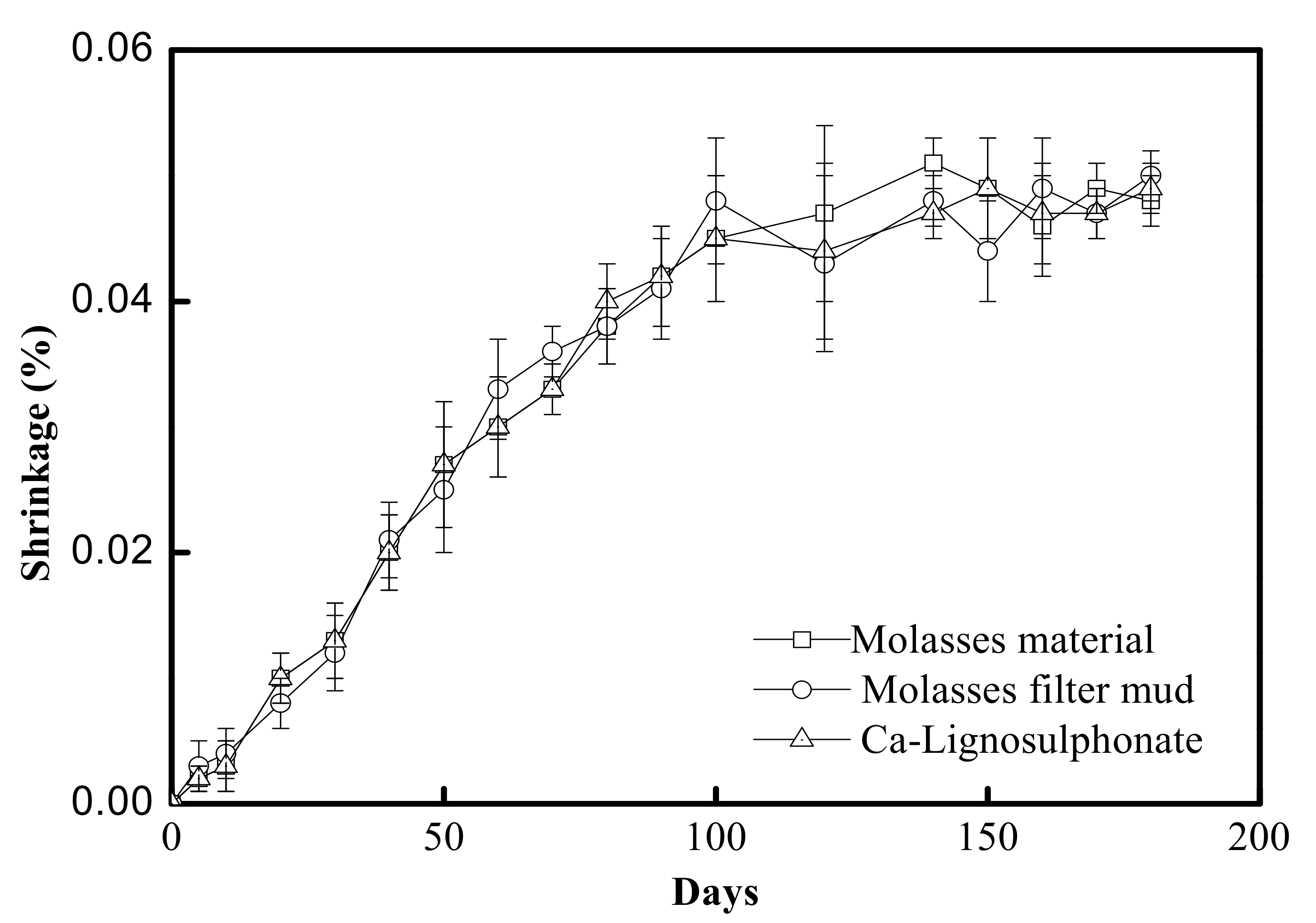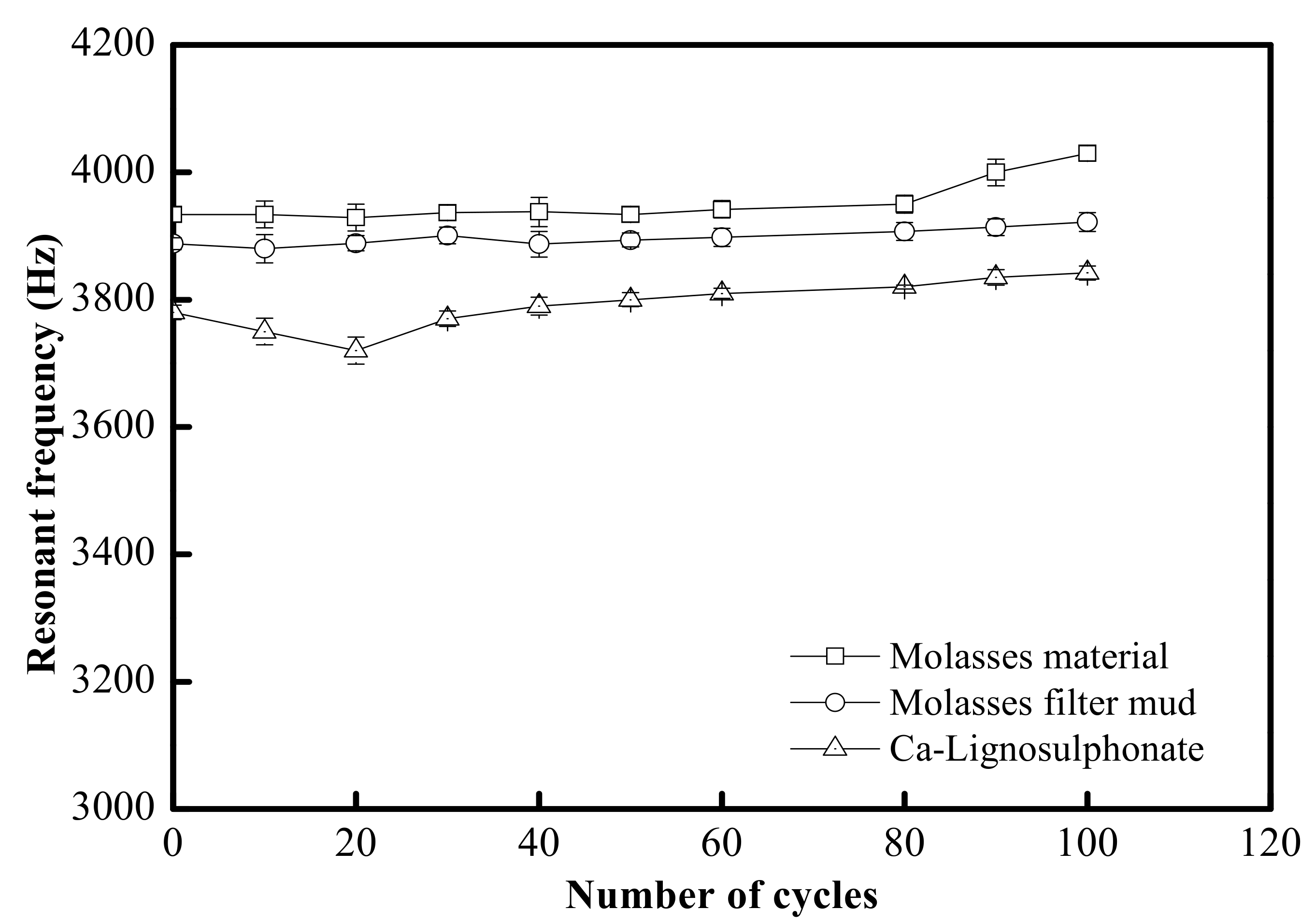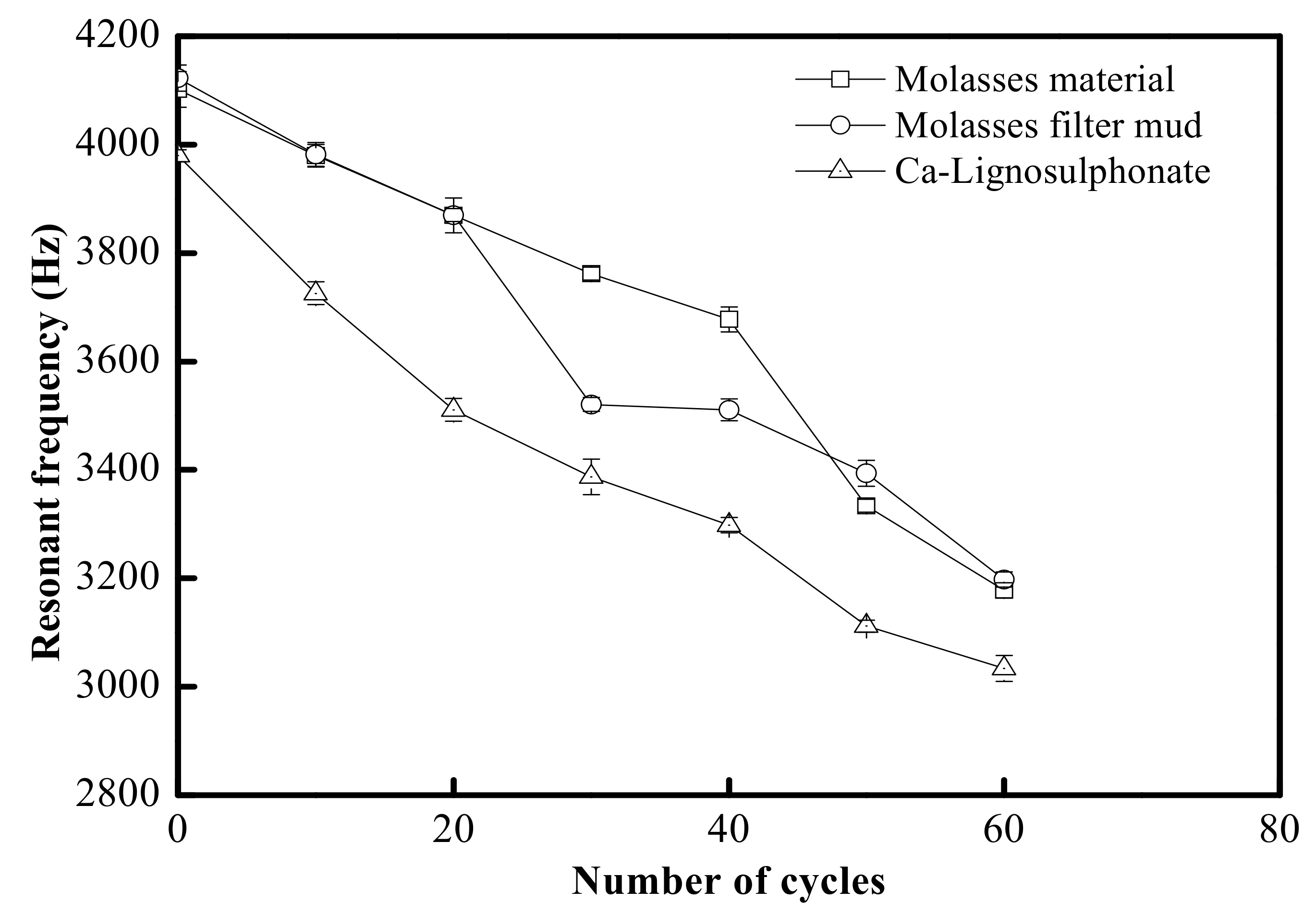Retardation Effects of Filter Mud in Molasses on Composite Silicate Cement
Abstract
:1. Introduction
2. Materials and Methods
2.1. Cement
2.2. Aggregates
2.3. Admixtures
2.4. Mortar and Concrete
2.5. Analysis
2.5.1. Initial Setting Time and Final Setting Time
2.5.2. Slump
2.5.3. Bleeding Rate
2.5.4. Compressive Strength
2.5.5. Others
3. Results and Discussion
3.1. Performance of Fresh Concrete
3.1.1. Setting Time
3.1.2. Slump
3.1.3. Bleed Water
3.2. Properties of Hardened Concrete
3.2.1. Compressive Strength
3.2.2. Water Absorption
3.2.3. Drying Shrinkage
3.2.4. Freezing and Thawing Properties
3.2.5. Wetting and Drying Properties
3.2.6. Carbonisation
4. Conclusions
Author Contributions
Funding
Institutional Review Board Statement
Informed Consent Statement
Data Availability Statement
Acknowledgments
Conflicts of Interest
References
- Dauzeres, A.; Bescop, P.L.; Sardini, P.; Coumes, C.C.D. Physico-chemical investigation of clayey/cement-based materials interaction in the context of geological waste disposal: Experimental approach and results. Cem. Concr. Res. 2010, 40, 1327–1340. [Google Scholar] [CrossRef]
- Lea, F.M. The Chemistry of Cement and Concrete; St. Martins Press: New York, NY, USA, 1956. [Google Scholar]
- Yuan, L.W.; Li, M.; Huang, Y.B.; Zhou, Z.H.; Luan, C.Q.; Ren, Z.C.; Liu, Y.Y.; Zhou, T.T.; Chen, X.; Wang, J.B. Improving the autogenous self-sealing of mortar: Influence of curing condition. Materials 2021, 14, 2068. [Google Scholar] [CrossRef] [PubMed]
- Kong, D.Y.; He, G.P.; Pan, H.W.; Weng, Y.H.; Du, N.; Sheng, J.S. Influences and mechanisms of nano-C-S-H gel addition on fresh properties of the cement-based materials with sucrose as retarder. Materials 2020, 13, 2345. [Google Scholar] [CrossRef] [PubMed]
- Ma, L.; Xie, Q.T.; Evelina, A.; Long, W.J.; Ma, C.F.; Zhou, F.S.; Cha, R.T. The effect of different additives on the hydration and gelation properties of composite dental gypsum. Gels 2021, 7, 117. [Google Scholar] [CrossRef] [PubMed]
- Cheng, B.J.; Yao, C.; Xiong, J.; Liu, X.Y.; Zhang, H.J.; Zhang, S.W. Effects of sodium hexametaphosphate addition on the dispersion and hydration of pure calcium aluminate cement. Materials 2020, 13, 5229. [Google Scholar] [CrossRef]
- Zha, X.X.; Zhang, K. The influence of sugar water reducer on recycled concrete research. Appl. Mech. Mater. 2011, 71, 3600–3604. [Google Scholar] [CrossRef]
- Ma, B.G.; Wang, J.R.; Li, X.G.; He, C.; Yang, H.T. The influence of oleic acid on the hydration and mechanical properties of portland cement. J. Wuhan Univ. Technol.-Mater. Sci. Ed. 2013, 13, 1177–1180. [Google Scholar] [CrossRef]
- Ramachandran, V.S.; Lowery, M.S. Conduction calorimetric investigation of the effect of retarders on the hydration of Portland cement. Thermochim. Acta 1992, 195, 373–387. [Google Scholar] [CrossRef]
- Milestone, N.B. Hydration of tricalcium silicate in the presence of lignosulphonates, glucose, and sodium gluconate. J. Am. Ceram. Soc. 1979, 62, 321–324. [Google Scholar] [CrossRef]
- Bruere, G.M. Set retarding effects of sugar in portland cement pastes. Nature 1966, 212, 502–503. [Google Scholar] [CrossRef]
- Zhou, X.; Zhou, X.L.; Tang, X.S.; Xu, Y. Process for calcium xylonate production as a concrete admixture derived from in-situ fermentation of wheat straw pre-hydrolysate. Bioresour. Technol. 2018, 261, 288–293. [Google Scholar] [CrossRef] [PubMed]
- Ashworth, R. Some investigations into the use of sugar as an admixture to concrete. Proc. Inst. Civ. Eng. 1963, 31, 129–145. [Google Scholar]
- Ferrandez-García, M.T.; Ferrandez-Garcia, C.E.; Garcia-Ortuño, T.; Ferrandez-Garcia, A.; Ferrandez-Villena, M. Study of waste jute fibre panels (Corchorus capsularis L.) agglomerated with Portland cement and starch. Polymers 2020, 12, 599. [Google Scholar] [CrossRef] [PubMed] [Green Version]
- Jiang, Y.M.; Ye, X.H.; Zheng, T.W.; Dong, W.L.; Xin, F.X.; Ma, J.F.; Jiang, M. Microbial production of L-malate from renewable nonfood feedstocks. Chin. J. Chem. Eng. 2021, 40, 1423–1432. [Google Scholar]
- Joshi, S.; Bharucha, C.; Jha, S.; Yadav, S.; Nerurkar, A.; Desai, A.J. Biosurfactant production using molasses and whey under thermophilic conditions. Bioresour. Technol. 2008, 99, 195–199. [Google Scholar] [CrossRef] [PubMed]
- Li, W.F.; Zhang, S.B.; Cheng, Y.C.; Ma, S.H.; Shen, X.D. Effect of modified cane molasses on the properties of Portland cement. New Build. Mater. 2013, 3, 4. [Google Scholar]
- Zeng, X.H.; Lan, X.L.; Zhu, H.S.; Liu, H.C.; Umar, H.A.; Xie, Y.J.; Long, G.C.; Ma, C. A review on bubble stability in fresh concrete: Mechanisms and main factors. Materials 2020, 13, 1820. [Google Scholar] [CrossRef] [Green Version]
- Jumadurdiyev, A.; Ozkul, M.H.; Saglam, A.R.; Parlak, N. The utilization of beet molasses as a retarding and water-reducing admixture for concrete. Cem. Concr. Res. 2005, 35, 874–882. [Google Scholar] [CrossRef]
- Nowak-Michta, A. Additional porosity as a side effect of polycarboxylate addition and its influence on concrete’s scaling resistance. Materials 2020, 13, 316. [Google Scholar] [CrossRef] [Green Version]
- Zhang, Y.M. The Modification and Application of Sugar Beet Molasses; University of Jinan: Shandong, China, 2012. [Google Scholar]
- Pichniarczyk, P. Influence of methylcellulose on the hydration of cement. Cem. Wapno Beton 2015, 3, 186–192. [Google Scholar]
- Tuthill, L.H.; Adams, R.F.; Hemme, J.M. Observations in testing and use of water-reducing retarders. ASTM Spec. Publ. 1960, 266, 97–117. [Google Scholar]
- Torgal, F.P.; Miraldo, S.; Labrincha, J.A.; Brito, J.D. An overview on concrete carbonation in the context of eco-efficient construction: Evaluation, use of scms and/or rac. Constr. Build. Mater. 2012, 36, 141–150. [Google Scholar] [CrossRef] [Green Version]
- Jiang, X.Y.; Zhao, J.X. Separation of crude phenols from bamboo tar and modification of aminobenzenesulfonic-based superplasticizer. Adv. Mater. Res. 2011, 168, 2214–2218. [Google Scholar] [CrossRef]
- Alunno-Rossetti, V.; Chiocchio, G.; Collepardi, M. Influence of precuring on high pressure steam hydration of tricalcium silicate. Cem. Concr. Res. 1974, 3, 665–676. [Google Scholar] [CrossRef]
- Li, J.; Yao, Y. A study on creep and drying shrinkage of high performance concrete. Cem. Concr. Res. 2001, 31, 1203–1206. [Google Scholar] [CrossRef]







| Physical Properties | Mechanical Properties |
|---|---|
| Density (g/m3) 3.15 | Compressive strength/MPa 3 d 25.4 7 d 35.8 28 d 46.3 |
| Blaine sp. surface (cm2/g) 3900 | Chemical components/% C3S (Tricalcium silicate) 52.74 C2S (Dicalcium silicate) 15.63 C3A (Tricalcium aluminate) 4.01 C4AF (Fe-Aluminate) 13.22 |
| Grade Degree of fineness (80 μm) 3.8% Degree of fineness (30 μm) 10.9% | |
| Setting time (min) Beginning time 150 ± 10 Final setting time 265 ± 10 |
| Composition | Molasses Material/% | Filter Mud/% | Molasses Colloids/% | Sugar Liquid/% |
|---|---|---|---|---|
| Free sugar | 52.81 ± 0.02 | 3.98 ± 0.18 | -- a | 40.60 ± 2.45 |
| Colloids | 15.92 ± 1.25 | 2.25 ± 0.08 | 12.85 ± 1.14 | -- |
| Holocellulose | 3.22 ± 0.14 | 3.22 ± 0.58 | -- | -- |
| Ash | 5.05 ± 0.79 | 1.75 ± 0.67 | 1.36 ± 0.02 | 1.23 ± 0.11 |
| Admixture Ratio | 0% | 0.2% | 0.4% | 0.8% | ||||
|---|---|---|---|---|---|---|---|---|
| Start/min | End/min | Start/min | End/min | Start/min | End/min | Start/min | End/min | |
| Ca-lignosulfonate | 150 ± 10 | 265 ± 10 | 210 ± 8 | 311 ± 10 | 282 ± 5 | 363 ± 13 | 413 ± 12 | 538 ± 3 |
| Molasses material | 150 ± 10 | 265 ± 10 | 454 ± 11 | 558 ± 6 | 732 ± 13 | 985 ± 17 | 920 ± 11 | 1258 ± 12 |
| Water-soluble pigment | 150 ± 10 | 265 ± 10 | 150 ± 2 | 265 ± 12 | 153 ± 8 | 267 ± 9 | 155 ± 11 | 272 ± 9 |
| Sugars | 150 ± 10 | 265 ± 10 | 421 ± 12 | 500 ± 10 | 673 ± 2 | 863 ± 22 | 888 ± 21 | 1098 ± 28 |
| Sucrose | 150 ± 10 | 265 ± 10 | 423 ± 23 | 503 ± 2 | 688 ± 12 | 877 ± 12 | 900 ± 12 | 1197 ± 20 |
| Molasses colloids | 150 ± 10 | 265 ± 10 | 113 ± 17 | 228 ± 19 | 98 ± 10 | 189 ± 18 | 65 ± 11 | 132 ± 10 |
| Filter mud in molasses | 150 ± 10 | 265 ± 10 | 298 ± 11 | 416 ± 7 | 485 ± 12 | 738 ± 21 | 752 ± 14 | 1072 ± 16 |
| Admixture Content/% | Molasses Material | Filter Mud | Ca-Lignosulfonate |
|---|---|---|---|
| Fresh concrete/cm | |||
| 0.2 | 14.8 ± 0.2 | 15.7 ± 0.3 | 17.0 ± 0.3 |
| 0.4 | 18.7 ± 0.2 | 19.9 ± 0.4 | 21.8 ± 0.5 |
| Air contents/% | |||
| 0.2 | 0.5 ± 0.05 | 0.8 ± 0.03 | 1.4 ± 0.05 |
| 0.4 | 0.7 ± 0.02 | 1.0 ± 0.05 | 1.8 ± 0.03 |
| Condition | Sorptivity (mm/min) | ||
|---|---|---|---|
| Molasses Material | Filter Mud | Ca-Lignosulfonate | |
| 28 d in water | 0.238 ± 0.15 | 0.221 ± 0.12 | 0.164 ± 0.08 |
| Admixture | ||||
|---|---|---|---|---|
| Molasses Material | Filter Mud | Ca-Lignosulfonate | ||
| Ultrasound velocity(km/s) | Initial | 4216 ± 20 | 4223 ± 12 | 4219 ± 15 |
| After 100 cycles | 3949 ± 15 | 3923 ± 21 | 3690 ± 7 | |
| Change/% | 6.33 ± 0.25 | 7.10 ± 1.33 | 12.54 ± 0.98 | |
| Weight of specimen/g | Initial | 12,230 ± 25 | 12,246 ± 23 | 12,126 ± 12 |
| After 100 cycles | 12,143 ± 11 | 12,146 ± 17 | 12,035 ± 24 | |
| Change/% | 0.71 ± 0.11 | 0.82 ± 0.13 | 0.75 ± 0.22 | |
| Admixture | ||||
|---|---|---|---|---|
| Molasses Material | Filter Mud | Ca-Lignosulfonate | ||
| Ultrasound velocity (km/s) | Initial | 4423 ± 14 | 4435 ± 21 | 4322 ± 32 |
| After 60 cycles | 3776 ± 12 | 3679 ± 35 | 3580 ± 23 | |
| Change/% | 14.63 ± 1.35 | 17.05 ± 2.11 | 17.17 ± 2.41 | |
| Weight of specimen/g | Initial | 12,318 ± 25 | 12,352 ± 23 | 12,245 ± 12 |
| After 60 cycles | 12,103 ± 25 | 12,188 ± 22 | 11,947 ± 14 | |
| Change/% | 1.75 ± 0.14 | 1.32 ± 0.24 | 2.43 ± 0.15 | |
Publisher’s Note: MDPI stays neutral with regard to jurisdictional claims in published maps and institutional affiliations. |
© 2022 by the authors. Licensee MDPI, Basel, Switzerland. This article is an open access article distributed under the terms and conditions of the Creative Commons Attribution (CC BY) license (https://creativecommons.org/licenses/by/4.0/).
Share and Cite
He, X.; Jiang, H.; Wan, X.; Chen, K.; Ouyang, P. Retardation Effects of Filter Mud in Molasses on Composite Silicate Cement. Materials 2022, 15, 3989. https://doi.org/10.3390/ma15113989
He X, Jiang H, Wan X, Chen K, Ouyang P. Retardation Effects of Filter Mud in Molasses on Composite Silicate Cement. Materials. 2022; 15(11):3989. https://doi.org/10.3390/ma15113989
Chicago/Turabian StyleHe, Xun, Hui Jiang, Xin Wan, Kequan Chen, and Pingkai Ouyang. 2022. "Retardation Effects of Filter Mud in Molasses on Composite Silicate Cement" Materials 15, no. 11: 3989. https://doi.org/10.3390/ma15113989
APA StyleHe, X., Jiang, H., Wan, X., Chen, K., & Ouyang, P. (2022). Retardation Effects of Filter Mud in Molasses on Composite Silicate Cement. Materials, 15(11), 3989. https://doi.org/10.3390/ma15113989





